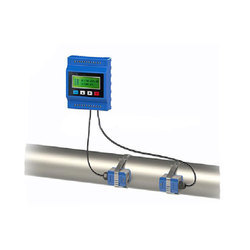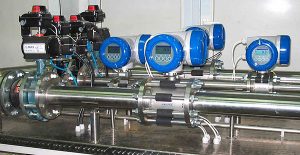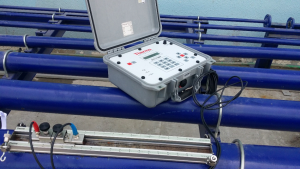Ultrasonic Flow meter Master Calibrator
Ultrasonic Flow Meter :
 Ultrasonic meters are rapidly turning into probably the most generally utilized meters in flow measurement. As of now ultrasonic meters are being used to quantify flammable gas, steam, air, water, fluid hydrocarbons, and different liquids. A portion of the real advantages of ultrasonic meters incorporate the analytic capacities, the way that there is no obstruction to the flow stream, and the wide turn down abilities of the meters.
Ultrasonic meters are rapidly turning into probably the most generally utilized meters in flow measurement. As of now ultrasonic meters are being used to quantify flammable gas, steam, air, water, fluid hydrocarbons, and different liquids. A portion of the real advantages of ultrasonic meters incorporate the analytic capacities, the way that there is no obstruction to the flow stream, and the wide turn down abilities of the meters.
The ultrasonic flow meter gives various favourable circumstances over different kinds of flow estimating meters. The principle advantage gave is ultrasonic measurements are non-intrusive. The flow of liquid is estimated by clamping an arrangement of transducers on a pipe. Since much of the time the transducers are set outwardly, they don’t interact with the liquid.
There are various modern applications that require the exact flow measurement. Be that as it may, traditional strategies aren’t generally an option, consequently the requirement for non-ruinous, non-intrusive advances and techniques. Ultrasonic flow meters are the hardware of decision at whatever point the contact with the deliberate liquid isn’t conceivable. Ultrasonic measurements are made by connecting two transducers onto the outside of a pipe.
This installation technique is ideal for all situations in which neither cutting the funnels nor the closing down of the process aren’t conceivable. These remotely connected flow meters don’t endure any mechanical wear and tear. They don’t make the weight drop, and they can be utilized for bidirectional measurements.
This technique is unique in relation to other flow meters. It is flawless when an application can’t be closed down or a pipe can’t be cut amid installation. No weight drops are knowledgeable about clamp-on flow meters. The flow meter won’t endure typical wear and tear. Bidirectional measurements should be possible with clamp-on flow meters.
There are two types of ultrasonic technologies:
- Transit-time
- Doppler techniques.
Transit time ultrasonic flow meters: Transit time ultrasonic flow meters measure the time contrast between the ultrasonic heartbeat going upstream and the one engendering downstream. These sound waves are created by a couple of transducers.
Doppler Ultrasonic Flow meters: Doppler ultrasonic flow meters depend on the Doppler-move or the phenomenon in which the wavelength of a moving toward sound source is shorter than the wavelength of that same source as it is moving without end.
Calibration of Ultrasonic meters sizes NPS 3 – NPS 30 to most extreme limit Flow capacity of 30 m3/hour through 55,000+ m3/hour accessible year-round
Stabile gas speeds of 1 ft/sec to more than 100 ft/sec accessible
Pressure go from 60 through 70 Bar (approx. 950-1050 PSI)
Calibration of ANSI 600, 900, 1500, 2500 arrangement Ultrasonic Meters
Real-time coordinate size, coordinate resolution committed per reference USM check metering
Simultaneous operation of devoted meter programming amid calibration
Ethernet connect accessible to meter amid calibration
Simultaneous, arrangement calibration of two Ultrasonic meters
Bi-directional calibration capacity
Internationally perceived measurement traceable to essential national benchmarks
AGA 9 and ISO 17025 Compliant calibration method and authentication
On-Site Meter Repair Capability and in-house parts stock

 A more limited meaning of the term calibration basically includes contrasting an instrument or measuring device with a standard, without influencing a change in accordance with make the instrument to peruse effectively. The second step, including change or “resetting the scale,” is once in a while called check. In customary utilize, be that as it may, a great many people incorporate the confirmation venture in the standard process of calibration or re calibration.
A more limited meaning of the term calibration basically includes contrasting an instrument or measuring device with a standard, without influencing a change in accordance with make the instrument to peruse effectively. The second step, including change or “resetting the scale,” is once in a while called check. In customary utilize, be that as it may, a great many people incorporate the confirmation venture in the standard process of calibration or re calibration.